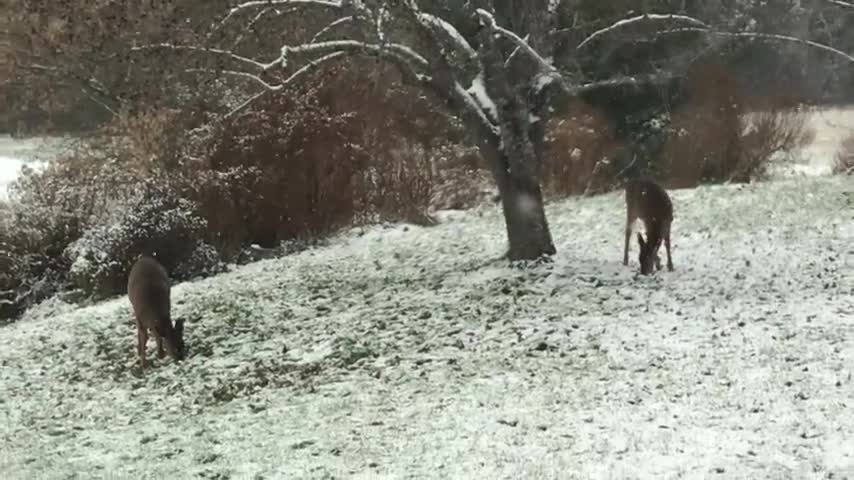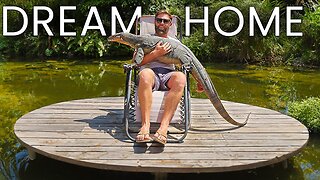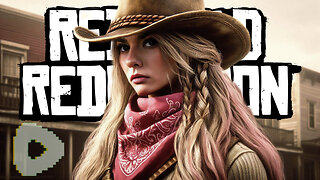Premium Only Content

Baby deer & mom frolic in first snow of the season
Such a beautiful sight to wake up to. This mom and 2 small fawns stopped out on my back property to feed on the apples and berries.
Here in New Hampshire, the white-tailed deer population is approximately 100,000 individuals. The areas of greatest densities are in the southern counties (Rockingham, Hillsborough, and Cheshire) and along the Connecticut River Valley (Grafton County). In 2014, the NH Fish and Game Department began the process of revising its 10-year management plan for white-tailed deer, moose, turkey, black bear, snowshoe hare, and ruffed grouse.
This document, called the NH Game Management Plan, spans the period of 2016 to 2025. Population level goals for deer were adjusted to more closely reflect current biological conditions and limitation, as well as public interests and concerns. These goals aim to stabilize the deer population in many areas of the state while increasing or reducing it in others.
Habits and Habitats
White-tailed deer can live in a variety of habitats, including farmlands, brushy areas, woods, mountains, and suburbs and gardens. They feed on green plants, including aquatic species in the summer, acorns, beechnuts, and corn in the fall, and woody vegetation, including buds and twigs of birch, maple and conifers in the winter. White-tailed deer will typically consume 5 to 9 pounds of food each day and find water from snow, dew and waterbodies.
Individual deer group into two types of social combinations. These include the family group, with a doe and her young, and the buck group. The family group will stay together for approximately a year. Buck groups are structured with a dominance hierarchy of 3 to 5 individuals. Bucks will challenge each other with stares, lowered ears, kicking, sparring (physically pushing each other back), and less commonly, thrashing of forefeet.
During the winter, these two deer groups may come together, forming communities of up to 150 individuals in locations called “yards.” This unification keeps trails open and accessible for feeding and also provides protection from predators. However, there have been problems with humans providing supplementary feed sites for deer in the winter. These sites can cause unnaturally high densities of congregated deer that attract predators, increase the risk of disease transmission, increase aggression within the community, and lead to over-browsing of local vegetation and more deer-vehicle collisions. They cause deer to be more dependent on humans and artificial food sources that provide few benefits.
-
 37:55
37:55
Forrest Galante
6 hours agoPrivate Tour of The World's Best Backyard Reptile Zoo
20.3K5 -
 14:38
14:38
Exploring With Nug
1 day ago $22.05 earnedWe Found the Secret That This Lake Has Been Hiding For Decades!
68.6K7 -
 9:20:53
9:20:53
SpartanTheDogg
14 hours agoPro Halo Player
28.5K1 -
 23:23
23:23
MYLUNCHBREAK CHANNEL PAGE
1 day agoAustralia Was Found
74.1K61 -
 1:41:45
1:41:45
The Connect: With Johnny Mitchell
14 hours ago $14.35 earnedMexican Cartels Are Moving MORE Drugs Than Ever, Going To WAR On The Government (Emergency Update)
42.8K5 -
 6:54:01
6:54:01
MissesMaam
10 hours agoFinishin' Red Dead Redemption 💚✨
67.1K7 -
 34:44
34:44
LFA TV
5 days agoMIRACLES DO HAPPEN!
80K1 -
 5:26:31
5:26:31
GamersErr0r
6 hours ago $3.47 earnedMooning My Community
36.4K -
 2:22:59
2:22:59
Banks Atkin Live
8 hours agoChilling playing Games & Vibin
62.9K1 -
 8:08:50
8:08:50
Dragoon_B
10 hours agoNothing crazy - just Counter Strike + Valorant
26.4K1